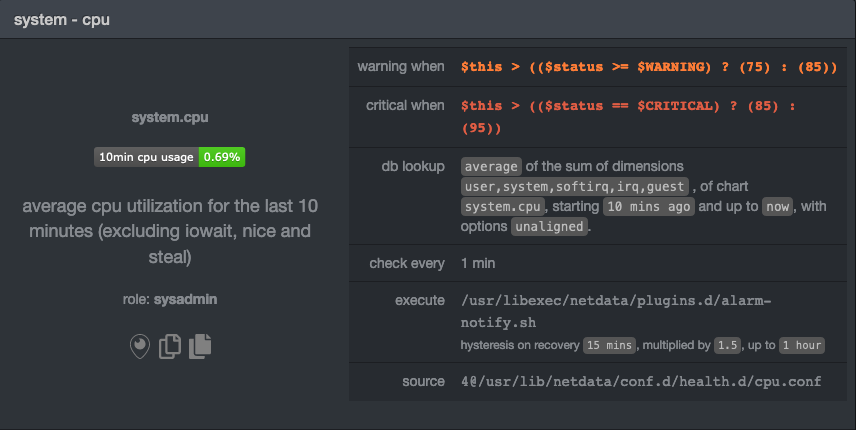1
2
3
4
5
6
7
8
9
10
11
12
13
14
15
16
17
18
19
20
21
22
23
24
25
26
27
28
29
30
31
32
33
34
35
36
37
38
39
40
41
42
43
44
45
46
47
48
49
50
51
52
53
54
55
56
57
58
59
60
61
62
63
64
65
66
67
68
69
70
71
72
73
74
75
76
77
78
79
80
81
82
83
84
85
|
# Stop notifications for individual alarms
In this short tutorial, you'll learn how to how to stop notifications for individual alarms in Netdata's health
monitoring system. We also refer to this process as _silencing_ the alarm.
Why silence alarms? We designed Netdata's pre-configured alarms for production systems, so they might not be
relevant if you run Netdata on your laptop or a small virtual server. If they're not helpful, they can be a distraction
to real issues with health and performance.
Silencing individual alarms is an excellent solution for situations where you're not interested in seeing a specific
alarm but don't want to disable a [notification system](../notifications/README.md) entirely.
## Find the alarm configuration file
To silence an alarm, you need to know where to find its configuration file.
Let's use the `system.cpu` chart as an example. It's the first chart you'll see on most Netdata dashboards.
To figure out which file you need to edit, open up Netdata's dashboard and, click the **Alarms** button at the top
of the dashboard, followed by clicking on the **All** tab.
In this example, we're looking for the `system - cpu` entity, which, when opened, looks like this:

In the `source` row, you see that this chart is getting its configuration from
`4@/usr/lib/netdata/conf.d/health.d/cpu.conf`. The relevant part of begins at `health.d`: `health.d/cpu.conf`. That's
the file you need to edit if you want to silence this alarm.
For more information about locating health configuration files on your system, see the [health
quickstart](../QUICKSTART.md#locate-health-configuration-files).
## Edit the file to enable silencing
To edit `health.d/cpu.conf`, use `edit-config` from inside of your Netdata configuration directory.
```bash
cd /etc/netdata/ # Replace with your Netdata configuration directory, if not /etc/netdata/
./edit-config health.d/cpu.conf
```
> You may need to use `sudo` or another method of elevating your privileges.
The beginning of the file looks like this:
```yaml
template: 10min_cpu_usage
on: system.cpu
os: linux
hosts: *
lookup: average -10m unaligned of user,system,softirq,irq,guest
units: %
every: 1m
warn: $this > (($status >= $WARNING) ? (75) : (85))
crit: $this > (($status == $CRITICAL) ? (85) : (95))
delay: down 15m multiplier 1.5 max 1h
info: average cpu utilization for the last 10 minutes (excluding iowait, nice and steal)
to: sysadmin
```
To silence this alarm, change `sysadmin` to `silent`.
```yaml
to: silent
```
Use `killall -USR2 netdata` to reload your health configuration and ensure you get no more notifications about that
alarm.
You can add `to: silence` to any alarm you'd rather not bother you with notifications.
## What's next?
You should now know the fundamentals behind silencing any individual alarm in Netdata.
To learn about _all_ of Netdata's health configuration possibilities, visit the [health reference
guide](../REFERENCE.md), or check out other [tutorials on health monitoring](../README.md#tutorials).
Or, take better control over how you get notified about alarms via the [notification
system](../notifications/README.md).
You can also use Netdata's [Health Management API](../../web/api/health/README.md#health-management-api) to control
health checks and notifications while Netdata runs. With this API, you can disable health checks during a maintenance
window or backup process, for example.
|
